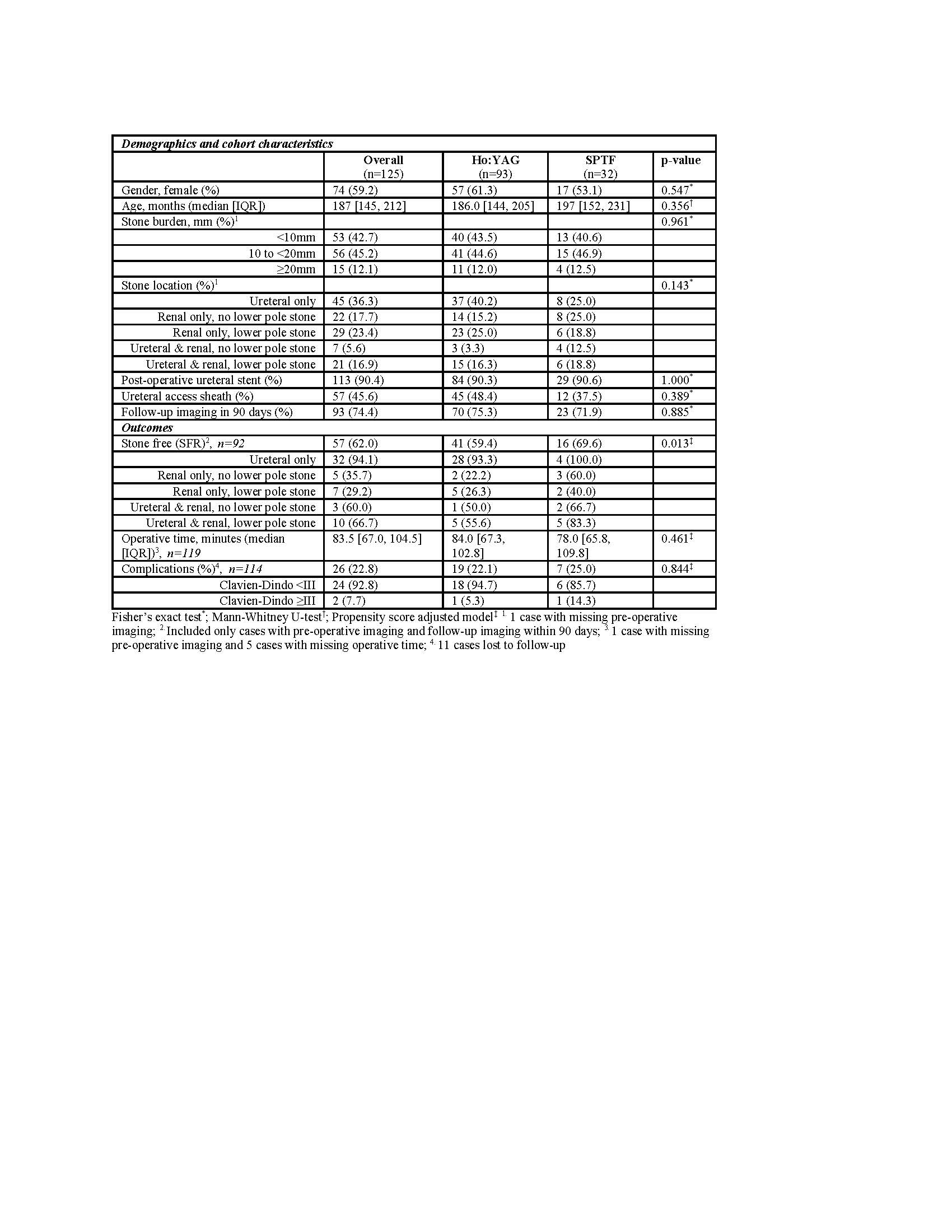Back
Poster, Podium & Video Sessions
Podium
PD48: Pediatic Urology: Genitalia, Upper & Lower Urinary Tract
PD48-02: Is the Thulium Fiber Laser Superior to the Low-Power Ho:YAG Laser for Ureteroscopy in Children?
Sunday, May 15, 2022
1:10 PM – 1:20 PM
Location: Room 244
Christopher Jaeger*, Caleb Nelson, Bartley Cilento, Tanya Logvinenko, Michael Kurtz, Boston, MA
.jpg)
Christopher D. Jaeger, MD (he/him/his)
Oakland University William Beaumont School of Medicine
Podium Presenter(s)
Introduction: The Holmium:yttrium-aluminum-garnet (Ho:YAG) laser has been the laser lithotripsy gold standard for several decades. The Thulium fiber laser is a new technology with unique technical properties emerging as a safe and effective alternative to Ho:YAG in adult series. Our free-standing children’s hospital recently adopted the Super Pulsed Thulium Fiber Laser (SPTF) from Olympus, which is the first such platform on the market in North America. Our objective was to compare clinical outcomes in consecutive pediatric ureteroscopies using a low-power Ho:YAG laser or the SPTF system at our center.
Methods: This is a retrospective cohort study of all unilateral ureteroscopies with laser lithotripsy performed by 3 surgeons for renal or ureteral stones at our center from 2016-2021. Demographics and procedure characteristics were compared between SPTF and Ho:YAG cases using Fisher’s Exact and Mann-Whitney U tests. Complications within 30 days of surgery and stone free status, defined as the absence of a stone fragment on follow-up imaging within 90 days of surgery, were analyzed using logistic regression. Operative times were compared using linear regression. Propensity scores using stone burden, stone location, and surgeon were constructed. Inverse probability of treatment weighting was used to account for imbalance between the cohorts.
Results: 125 ureteroscopies with laser lithotripsy were performed on 109 pediatric patients: 93 with Ho:YAG and 32 with SPTF. No significant difference was noted in age (p=0.36), gender (p=0.55), stone burden (p=0.96), or stone location (p=0.14). For the 92 ureteroscopies with 90 day follow-up imaging, the stone free rate (SFR) was 62%; 70% with SPTF and 59% with Ho:YAG. The odds of having a residual stone fragment were significantly lower with SPTF than with Ho:YAG (OR=0.46 (95% CI: 0.24-0.84), p=0.01). There was no significant difference in operative time (p=0.46). 7 (25%) complications were noted with SPTF and 19 (22%) with Ho:YAG (p=0.84). 2 complications were Clavien-Dindo =III; but were not directly attributed to a laser.
Conclusions: For ureteroscopies in children, the SPTF using Thulium fiber laser technology improves the SFR achieved with low-power Ho:YAG lasers without compromising operative time or safety.
Source of Funding: N/A

Methods: This is a retrospective cohort study of all unilateral ureteroscopies with laser lithotripsy performed by 3 surgeons for renal or ureteral stones at our center from 2016-2021. Demographics and procedure characteristics were compared between SPTF and Ho:YAG cases using Fisher’s Exact and Mann-Whitney U tests. Complications within 30 days of surgery and stone free status, defined as the absence of a stone fragment on follow-up imaging within 90 days of surgery, were analyzed using logistic regression. Operative times were compared using linear regression. Propensity scores using stone burden, stone location, and surgeon were constructed. Inverse probability of treatment weighting was used to account for imbalance between the cohorts.
Results: 125 ureteroscopies with laser lithotripsy were performed on 109 pediatric patients: 93 with Ho:YAG and 32 with SPTF. No significant difference was noted in age (p=0.36), gender (p=0.55), stone burden (p=0.96), or stone location (p=0.14). For the 92 ureteroscopies with 90 day follow-up imaging, the stone free rate (SFR) was 62%; 70% with SPTF and 59% with Ho:YAG. The odds of having a residual stone fragment were significantly lower with SPTF than with Ho:YAG (OR=0.46 (95% CI: 0.24-0.84), p=0.01). There was no significant difference in operative time (p=0.46). 7 (25%) complications were noted with SPTF and 19 (22%) with Ho:YAG (p=0.84). 2 complications were Clavien-Dindo =III; but were not directly attributed to a laser.
Conclusions: For ureteroscopies in children, the SPTF using Thulium fiber laser technology improves the SFR achieved with low-power Ho:YAG lasers without compromising operative time or safety.
Source of Funding: N/A


.jpg)
.jpg)